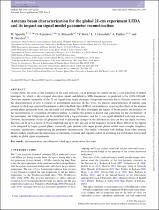Antenna beam characterization for the global 21-cm experiment LEDA and its impact on signal model parameter reconstruction
| dc.contributor.author | Spinelli, Marta | |
| dc.contributor.author | Kyriakou, George A. | |
| dc.contributor.author | Bernardi, Gianni | |
| dc.date.accessioned | 2022-09-20T08:07:22Z | |
| dc.date.available | 2022-09-20T08:07:22Z | |
| dc.date.issued | 2022 | |
| dc.identifier.citation | Spinelli, M. et al. (2022). Antenna beam characterization for the global 21-cm experiment LEDA and its impact on signal model parameter reconstruction. Monthly Notices of the Royal Astronomical Society, 515(2), 1580-1597. 10.1093/mnras/stac1804 | en_US |
| dc.identifier.issn | 1365-2966 | |
| dc.identifier.uri | 10.1093/mnras/stac1804 | |
| dc.identifier.uri | http://hdl.handle.net/10566/7922 | |
| dc.description.abstract | Cosmic dawn, the onset of star formation in the early universe, can in principle be studied via the 21-cm transition of neutral hydrogen, for which a sky-averaged absorption signal, redshifted to MHz frequencies, is predicted to be O(10-100) mK. Detection requires separation of the 21-cm signal from bright chromatic foreground emission due to Galactic structure, and the characterization of how it couples to instrumental response. In this work, we present characterization of antenna gain patterns for the Large-aperture Experiment to detect the Dark Ages (LEDA) via simulations, assessing the effects of the antenna ground-plane geometries used, and measured soil properties. | en_US |
| dc.language.iso | en | en_US |
| dc.publisher | Oxford University Press | en_US |
| dc.subject | Dark ages | en_US |
| dc.subject | Astronomy | en_US |
| dc.subject | Astrophysics | en_US |
| dc.subject | Antenna grounds | en_US |
| dc.subject | Cosmology | en_US |
| dc.title | Antenna beam characterization for the global 21-cm experiment LEDA and its impact on signal model parameter reconstruction | en_US |
| dc.type | Article | en_US |

